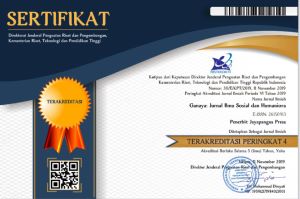Fungsionalisme Makna Simbolik Tradisi Ngampirne Weton
DOI:
https://doi.org/10.37329/ganaya.v8i2.4030Keywords:
Functionalism, Tradition, Ngampirne Weton, SymbolicAbstract
This research is motivated by the need to understand the meaning of the symbols contained in the ngampirne weton tradition. So that its role is considered as a symbol of unity and social solidarity as a means to share sustenance and strengthen social relations. This study aims to understand the symbolic meaning and function of the Ngampirne Weton tradition in Semen Village, Blitar Regency, East Java, as well as the community's views on this tradition. The ngampirne weton tradition is a tradition of commemorating someone's birthday based on the Javanese calendar by holding a thanksgiving. The research method used is qualitative with an ethnographic model, data collection through literature studies, in-depth interviews, participant observation, and documentation collection. The results of the study show that the ngampirne weton tradition contains symbolic meaning in every dish served. The foods that are symbols of this tradition are golong pithu, apem, buceng, porridge and asahan sekul sayur sakaturan. The community believes that carrying out the ngampirne weton tradition is a means of expressing gratitude, praying for safety, respecting ancestors and warding off bad luck. In addition to these beliefs, the community interprets it as a glue for cultural and community identity. Based on the research, it was found that the function of the ngampirne weton tradition is as a) religion, b) social balance c) strengthening cultural identity. Positive meanings and teachings are found in this tradition, including asking for safety and blessings from God Almighty, teaching to share with others through slametan, not only that, the value of gratitude, mutual cooperation is also manifested in the slametan. Understanding the meaning in each symbol of the ngampirne neton tradition needs to be done, by understanding it can be known the function of a meaning.
References
Agung, D. A. G. (2015). Pemahaman Awal Terhadap Anatomi Teori Sosial Dalam Perspektif Struktural Fungsional Dan Struktural Konflik. Sejarah Dan Budaya, 9(2), 162-170.
Dewantoro, S. H. (2017). Suwung: Ajaran Rahasia Leluhur Jawa. Banten: Javanica.
Durkheim, É. (1893). The Division of Labor in Society. New York London: Free Press.
Fahrudi, E., & Alfadhilah, J. (2022). Makna Simbolik “Bulan Suro” Kenduri Dan Selamatan Dalam Tradisi Islam Jawa. ASWALALITA: Journal Of Dakwah Management, 1(2), 185-195.
Hendro, E. P. (2020). Simbol: Arti, Fungsi, dan Implikasi Metodologisnya. Endogami: Jurnal Ilmiah Kajian Antropologi, 3(2), 158-165.
Hidayana, I. S., & Swaradesy, R. G. (2021). Pemaknaan Permainan Rakyat Pada Ritual Kematian Rambu Solo’Di Kampung Adat Ke’Te’Kesu’Kabupaten Toraja Utara Provinsi Sulawesi Selatan. Jurnal Panggung, 31(2), 93-109.
Kristianto, I. K. (2019). Kesenian Reyog Ponorogo dalam Teori Fungsionalisme. Tamumatra: Jurnal Seni Pertunjukan, 1(2).
Maliki, Z. (2012). Rekontruksi Teori Sosial Moderen. Yogyakarta: Gadjah Mada University Press.
Malinowski, B. (1944). A Scientific Theory of Culture and Other Essays. Chapel Hill. California: The University of North California Press.
Nafiah, D. (2020). Upacara Siraman Gong Yai Pradah Dan Pengaruh Bgai Masyarakat. Jakarta: Universitas Islam Negeri Syarif Hidayatullah.
Nuraseh, S. (2023). Selamatan Bersih Desa sebagai Wujud Ucapan Syukur dalam Kontradiksi Budaya Jawa: Jaman Dahulu dan Sekarang. Sabdasastra: Jurnal Pendidikan Bahasa Jawa, 7(1), 146-157.
Purwadi. (2008). Upacara Tradisi Jawa. Yogyakarta: Pustaka Pelajar.
Putri, L. P., Mahfud, M., & Yudiana, I. K. Y. (2024). Dinamika Sosial Dan Budaya Dalam Tradisi Metik Pari. Jurnal Sangkala, 3(2), 78-89.
Ramadhani, A. F., & Muzaiyana, M. (2022). Eksistensi Tradisi Bersih Desa Baleturi Prambon Ngranjuk. Qurthuba: The Journal of History and Islamic Civilization, 6(1), 78-88.
Riitzeir, G. (2008). Teiori Sosiologi: Darii Klasik sampai Perkembangan Mutakhir Teiori Sosial Postmodeirn. Yogyakarta: Kreiasii Wacana.
Rina, & Susanti, D. (2017). Tradisi Kenduri Dalam Masyarakat Jawa Pada Perayaan Hari Raya Galungan Di Desa Purwosari Kecamatan Tegaldlimo Kabupaten Banyuwangi (Kajian Teologi Hindu). Jurnal Penelitian Agama Hindu, 1(2), 489-495.
Rofiq, A. (2019). Tradisi Slametan Jawa Dalam Perpektif Pendidikan Islam. Attaqwa: Jurnal Ilmu Pendidikan Islam, 15(2), 93-107.
Rohman, F., & Awalin, N. (2018). Slametan: Perkembangannya Dalam Masyarakat Islam-Jawa Di Era Mileneal. Jurnal Ikadbudi, 7(1).
Rorong, M. J. (2020). Fenomenologi. Yogyakarta: Deepublish.
Safitri, M. A. (2021). Tradisi Perhitungan Weton dalam Pernikahan Masyarakat Jawa di Kabupaten Tegal; Studi Perbandingan Hukum Adat dan Hukum Islam. Shautung: Jurnal Ilmiah Mahasiswa Perbandingan Mazhab, 2(1).
Sari, N. (2018). Makna Tradisi Selametan Pada Masyarakat Suku Jawa Sumatera. Universitas Sumatera Utara.
Setiawan, E. (2019). Kajian Simbolisme Budaya Jawa. Cirebon: Eduvision.
Shobach, M. I., Ilham, S. M., Oktaviona, C., & Attar, M. F. (2022). Ancaman Westernisasi Terhadap Budaya Lokal Indonesia Dari Perspektif Komunikasi Massa. Prosiding Seminar Nasional Ilmu Ilmu Sosial (SNIIS), 1, 652-662.
Zakiyah, M., Setiawati, E., & Rohman, A. S. (2021). The Meaning of Puji Saji in Sura Offerings at Selametan Sumber Banyu or Tirta Amerta Ritual at Sumberawan Toyomarto Singosari Temple, Malang. ISCS 2020: Proceedings of the 1st International Seminar on Cultural Sciences, ISCS 2020, 4 November 2020, Malang, Indonesia.
Downloads
Published
How to Cite
Issue
Section
License
Copyright (c) 2025 Ariani Susilo, Ari Sapto, Deny Yudo, Dewa Agung (Author)

This work is licensed under a Creative Commons Attribution-ShareAlike 4.0 International License.
An author who publishes in the Ganaya : Jurnal Ilmu Sosial dan Humaniora agrees to the following terms:
- Author retains the copyright and grants the journal the right of first publication of the work simultaneously licensed under the Creative Commons Attribution-ShareAlike 4.0 License that allows others to share the work with an acknowledgement of the work's authorship and initial publication in this journal
- Author is able to enter into separate, additional contractual arrangements for the non-exclusive distribution of the journal's published version of the work (e.g., post it to an institutional repository or publish it in a book) with the acknowledgement of its initial publication in this journal.
- Author is permitted and encouraged to post his/her work online (e.g., in institutional repositories or on their website) prior to and during the submission process, as it can lead to productive exchanges, as well as earlier and greater citation of the published work (See The Effect of Open Access).
Read more about the Creative Commons Attribution-ShareAlike 4.0 Licence here: https://creativecommons.org/licenses/by-sa/4.0/.








